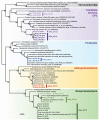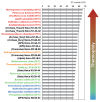Microbial diversity in the deep-subsurface hydrothermal aquifer feeding the giant gypsum crystal-bearing Naica Mine, Mexico
- PMID: 23508882
- PMCID: PMC3589807
- DOI: 10.3389/fmicb.2013.00037
Microbial diversity in the deep-subsurface hydrothermal aquifer feeding the giant gypsum crystal-bearing Naica Mine, Mexico
Abstract
The Naica Mine in northern Mexico is famous for its giant gypsum crystals, which may reach up to 11 m long and contain fluid inclusions that might have captured microorganisms during their formation. These crystals formed under particularly stable geochemical conditions in cavities filled by low salinity hydrothermal water at 54-58°C. We have explored the microbial diversity associated to these deep, saline hydrothermal waters collected in the deepest (ca. 700-760 m) mineshafts by amplifying, cloning and sequencing small-subunit ribosomal RNA genes using primers specific for archaea, bacteria, and eukaryotes. Eukaryotes were not detectable in the samples and the prokaryotic diversity identified was very low. Two archaeal operational taxonomic units (OTUs) were detected in one sample. They clustered with, respectively, basal Thaumarchaeota lineages and with a large clade of environmental sequences branching at the base of the Thermoplasmatales within the Euryarchaeota. Bacterial sequences belonged to the Candidate Division OP3, Firmicutes and the Alpha- and Beta-proteobacteria. Most of the lineages detected appear autochthonous to the Naica system, since they had as closest representatives environmental sequences retrieved from deep sediments or the deep subsurface. In addition, the high GC content of 16S rRNA gene sequences belonging to the archaea and to some OP3 OTUs suggests that at least these lineages are thermophilic. Attempts to amplify diagnostic functional genes for methanogenesis (mcrA) and sulfate reduction (dsrAB) were unsuccessful, suggesting that those activities, if present, are not important in the aquifer. By contrast, genes encoding archaeal ammonium monooxygenase (AamoA) were amplified, suggesting that Naica Thaumarchaeota are involved in nitrification. These organisms are likely thermophilic chemolithoautotrophs adapted to thrive in an extremely energy-limited environment.
Keywords: Candidate Division OP3; GC content; Thaumarchaeota; Thermoplasmatales; aerobic ammonium oxidation; hydrothermal; thermophile.
Figures






References
-
- Alva-Valdivia L. M., Goguitchaichvili A., Urrutia-Fucugauchi J. (2003). Petromagnetic properties in the Naica mining district, Chihuahua, Mexico: searching for source of mineralization. Earth Planets Space 55 19–31
-
- Erwood R. J., Kesler S. E., Cloke P. L. (1979). Compositionally distinct, saline hydrothermal solutions, Naica Mine, Chihuahua, Mexico. Econ. Geol. 74, 95–108
-
- Forti P., Sanna L. (2010). The Naica project – a multidisciplinary study of the largest gypsum crystal of the world. Episodes 33, 23–32
-
- Garcia-Ruiz J. M., Villasuso R., Ayora C., Canals A., Otalora F. (2007). Formation of natural gypsum megacrystals in Naica, Mexico. Geology 35, 327–330
-
- Garofalo P. S., Fricker M., Günther D., Mercuri A. M., Loreti M., Forti P., et al. (2010). A climatic control on the formation of gigantic gypsum crystals within the hypogenic caves of Naica (Mexico)? Earth Planet Sci. Lett. 289 560–569
LinkOut - more resources
Full Text Sources
Other Literature Sources
Molecular Biology Databases
Miscellaneous

